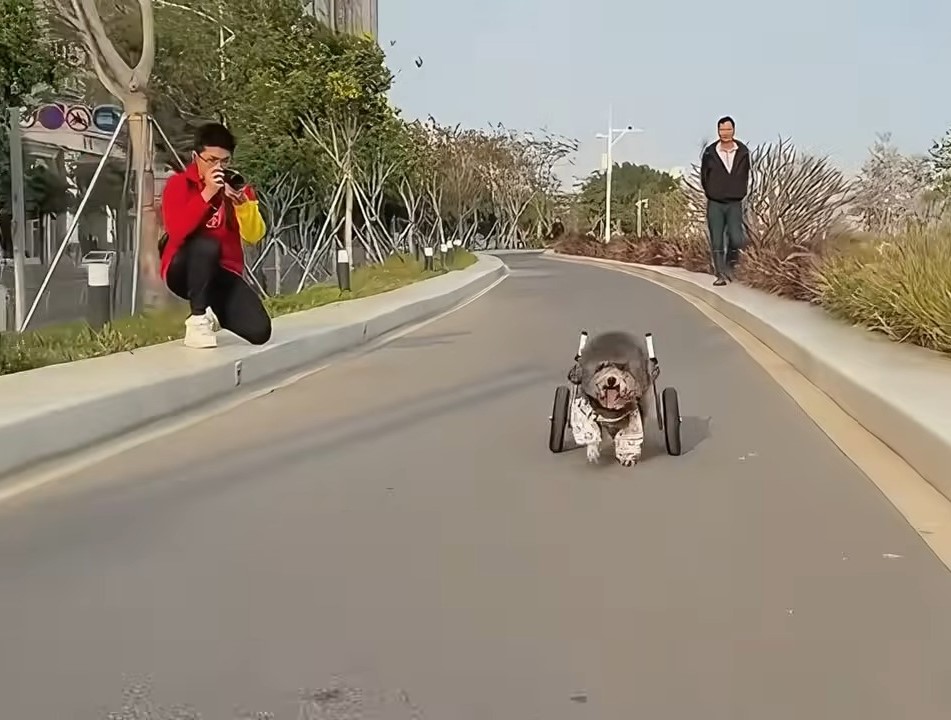I’ve been thinking lately about empathy for animals and why some people generally don’t have it while others do.
It’s one of the things that is not talked about a lot. Too often have we all seen a struggling stray limping around the road with most people just passing by and ignoring it.
This sweet dog had a lot of trouble moving, which made it really difficult for him to do anything until a man noticed him and decided to do something about it.
He Was So Friendly
 Source: Youtube
Source: Youtube
Just as soon as he stopped his car, the man got out and approached the dog. He was limping, and it was clear that something was wrong with him.
He was very friendly, however, and welcomed this attention. The man then went and brought him something to eat.
Who knows when his last meal was? He must have enjoyed this one a lot. The pup knew that this person wanted to help him, but he didn’t know how to ask for it.
The man then went about his business but noticed the pup in the same position when he was coming back.

He felt bad, so he gave the dog some more food and water. After that, he decided to call for help from a veterinarian clinic.
A vet was on the scene in no time, and she examined the pup. He had a severe skin infection, and his hind legs were paralyzed due to older injuries.
Unfortunately, there was no way he was going to move normally ever again, but the vets were still determined to help him lead a somewhat normal life.
They also groomed his matted fur and gave him a bath to get rid of all the fleas. He also received a deworming treatment.
A Brand-New Start

Now that he was clean, he enjoyed a very nice meal, and there was an instant shift in his mood. The pup was so happy to finally be receiving help.
He was so excited after his rescuer gave him a ball he could play with. In the meantime, the man decided to build him a custom wheelchair so he could move around easily.
After they installed it and mounted it on the dog, he was reluctant to move until he saw treats. His movement was a bit unstable, but nothing that practice couldn’t fix.

With some encouragement, he got a lot better and steadier. He even managed to run for a little bit.
So, his rescuer kept on taking him on daily walks on the advice of the veterinarians. He loved every second of it.
He went on many different adventures on a daily basis. His rescuer would take him to picnics, supermarkets, and even restaurants.
 Source: Youtube
Source: Youtube
The pup was always well-behaved and never made a mess. The man who rescued him decided to adopt him because he couldn’t imagine his life without this adorable dog.
As for the pup, he gets to enjoy his life with the people he cares about the most and it’s just heartwarming to see that he is finally happy.
If this story can teach us anything, it’s that rescuing a dog and giving it shelter can always change our lives in a very positive way, so it’s always important to give them a chance.
If you’ve ever had a pregnant dog in your care, you know the mix of excitement and anticipation it brings. The journey of a pregnant dog is a unique and heartwarming experience that requires attention and care. Understanding the timeline of a dog’s pregnancy is essential for providing the best support during this special time. From the initial stages to the final countdown, each moment is filled with its own set of milestones and developments that shape the upcoming arrival of adorable puppies into the world.
As a seasoned dog enthusiast, navigating the duration of a dog’s pregnancy can be both fascinating and rewarding. Witnessing the gradual transformation and growth of the mother dog is a testament to the wonders of nature. Stay tuned as we take a closer look at the stages and duration of a pregnant dog’s journey, offering insights and tips to ensure a smooth and healthy experience for both the expecting mother and her soon-to-arrive litter.
Understanding Dog Pregnancy
During dog pregnancy, it’s crucial to know that the gestation period for dogs is around 63 days. This timeline is divided into three stages: early, middle, and late pregnancy.
- Early Pregnancy (Weeks 1-3): In the initial weeks, your dog may not show visible signs of pregnancy. It’s a critical time for fetal development, so ensure she’s on a balanced diet and gets regular exercise.
- Middle Pregnancy (Weeks 4-6): By this stage, physical changes in your dog, such as weight gain and increased appetite, become more noticeable. It’s essential to schedule a vet visit for a check-up and to discuss prenatal care.
- Late Pregnancy (Weeks 7-9): As the delivery date approaches, your dog may display nesting behaviors, seek seclusion, and exhibit other signs like restlessness or panting. Provide a comfortable whelping box for her to deliver the puppies safely.
Understanding the signs of labor is crucial. These include a drop in body temperature, restlessness, panting, and nesting behaviors. When labor begins, stay calm, offer support, and contact your vet if needed.
Ensuring a stress-free environment for your pregnant dog is vital for her well-being and that of her puppies. Regular vet check-ups, proper nutrition, and a comfortable space for whelping are key to a successful pregnancy journey.
Remember, every dog is unique, so consult your vet for personalized guidance and care throughout the pregnancy. Enjoy this special time with your furry friend, and prepare to welcome the new additions to your family soon.
Signs of Pregnancy in Dogs
During your dog’s pregnancy journey, there are certain signs to look out for that indicate she may be expecting puppies soon. Here are the key signs of pregnancy in dogs:
- Changes in Behavior: Your dog may display changes in behavior such as increased affection, restlessness, or seeking more attention from you. These behavioral changes can be an early sign of pregnancy.
- Weight Gain: As the pregnancy progresses, your dog will likely experience weight gain. This weight gain is normal and essential for the health of the puppies developing inside her.
- Enlarged Abdomen: A visibly enlarged abdomen is a clear indication of pregnancy in dogs. As the puppies grow, your dog’s belly will expand to accommodate them.
- Nipple Growth and Color Changes: Another sign to watch for is the growth and darkening of your dog’s nipples. This change is a result of hormonal shifts during pregnancy.
- Nesting Behavior: In the late stages of pregnancy, your dog may exhibit nesting behavior, such as rearranging bedding or seeking out a quiet, secluded spot to give birth.
- Decreased Appetite: Some pregnant dogs may experience a temporary decrease in appetite, especially during the early stages of pregnancy. However, if appetite loss persists, consult your vet.
Monitoring these signs can help you track your dog’s progress during pregnancy and prepare for the arrival of the new pups. If you notice any concerning symptoms or behaviors, always consult your veterinarian for guidance and support.
Care During Dog Pregnancy
When it comes to caring for your pregnant dog, there are essential factors to keep in mind, ensuring her health and the well-being of the developing puppies.
Regular Veterinary Check-ups
During your dog’s pregnancy, it’s crucial to schedule regular check-ups with your veterinarian. They’ll monitor the pregnancy progress, offer advice on care, and address any concerns that may arise.
Nutritious Diet
Provide your pregnant dog with a well-balanced, high-quality diet suited for her changing needs. Consult your vet for specific dietary recommendations tailored to her stage of pregnancy.
Adequate Exercise
While exercise is essential, ensure your pregnant dog doesn’t engage in strenuous activities. Moderate exercise, such as short walks, helps maintain her muscle tone and overall health.
Comfortable Resting Area
Create a comfortable and quiet space for your pregnant dog to rest and nest. Consider a cozy bed in a secluded area where she feels secure and can prepare for the arrival of her puppies.
Monitoring Behavior Changes
Keep an eye on your dog for any unusual behavior changes, such as increased restlessness or nesting behavior. These signs can indicate that labor is approaching, and being aware of them is essential.
Emotional Support
Provide your pregnant dog with emotional support and attention during this time. Offer comfort and reassurance to help reduce any stress or anxiety she may be feeling.
Puppy Preparation
As the due date approaches, ensure you have all the necessary supplies ready for the arrival of the puppies. Items such as whelping boxes, clean blankets, and heating pads should be readily available.
Whelping Assistance
Be prepared for potential complications during labor. Familiarize yourself with the signs of labor difficulties and have your veterinarian’s contact information readily accessible in case of emergencies.
Postnatal Care
After the puppies are born, continue to provide care for your dog and her new offspring. Monitor the mother’s health, ensure the puppies are nursing well, and follow any postnatal care instructions given by your vet.
Taking these steps to care for your pregnant dog ensures a safe and comfortable pregnancy journey for her and the upcoming litter. Remember, each dog’s pregnancy experience is unique, so stay attentive and adaptable to her individual needs.
Preparing for the Arrival of Puppies
Ensure your pregnant dog has a designated, secluded area to give birth comfortably. Set up a whelping box with clean, soft bedding for the mother and her pups.
Have essential supplies ready, such as clean towels, scissors to cut the umbilical cords if needed, and a heating pad or heat lamp to maintain a warm environment for the newborns.
Prepare an emergency contact list that includes your veterinarian’s number and the closest emergency pet clinic in case you need immediate assistance during the birthing process.
Monitor your dog closely as her due date approaches. Look for signs of labor, like restlessness, panting, or nesting behavior, indicating that she’s getting ready to deliver.
Be prepared to offer assistance during labor if needed but allow the mother to handle the birthing process naturally. Consult your vet if you notice any concerning issues during labor.
After the puppies are born, let the mother clean them and encourage bonding by allowing her to nurse her pups. Observe the litter to ensure all the puppies are feeding and thriving.
Schedule a postnatal check-up for your dog and her puppies to ensure everyone is healthy. Follow your vet’s recommendations for vaccinations, deworming, and overall care for the mother and her new litter.
By preparing in advance and staying attentive during the birth and postnatal period, you can help ensure a smooth and successful delivery for your dog and her puppies.
Post-Whelping Care for the Mother Dog
After the birthing process, your dog will require special care to recover and nurse her newborns properly. Here’s what you need to do to ensure the mother dog’s well-being:
Monitor Her Health
Keep a close eye on the mother dog after she has given birth. Watch for any signs of complications such as excessive bleeding, fever, or abnormal behavior. If you notice anything concerning, contact your veterinarian immediately.
Provide Nutritious Food
Offer the mother dog high-quality, nutritious food to help her regain strength. She will need more calories during this time to support milk production for the puppies. Consult your vet for recommendations on a suitable diet.
Allow Bonding Time
Give the mother dog a calm and quiet space to bond with her puppies. Minimize stressors and potential interruptions to create a peaceful environment for her to care for and nurse her litter.
Schedule Vet Check-ups
Arrange postnatal check-ups for the mother dog to ensure she is recovering well. Your veterinarian can assess her health, check for any issues, and provide guidance on caring for the mother dog and her puppies.
Promote Rest and Relaxation
Encourage the mother dog to rest and relax as much as possible. Limit visitors and noise around her area to minimize stress. Adequate rest is essential for her recovery and the well-being of the puppies.
Observe for Behavioral Changes
Pay attention to any behavioral changes in the mother dog. While some changes are normal after giving birth, significant shifts in behavior or mood may indicate underlying issues that require veterinary attention.
By following these post-whelping care tips, you can help the mother dog recover fully and ensure a healthy start for her puppies.
Conclusion
That’s it for our guide on how long a pregnant dog is pregnant! Remember to keep an eye out for those important signs, set up a cozy spot for the birth, and be there to lend a helping hand if needed. After the puppies arrive, ensure the mama dog gets the care she deserves with nutritious meals, vet visits, and plenty of rest. By following these tips, you’ll be well-prepared for the exciting journey of welcoming new furry additions to your family.
Frequently Asked Questions
Q: How long is a dog’s gestation period?
A: A dog’s gestation period typically lasts 63 days from the time of conception to delivery.
Q: What are the signs of pregnancy in a dog?
A: Signs of pregnancy in a dog may include changes in appetite, weight gain, nipple growth, and behavioral changes.
Q: How can I prepare for my dog’s pregnancy?
A: To prepare for your dog’s pregnancy, set up a whelping box, gather necessary supplies, create an emergency contact list, and monitor your dog for labor signs.
Q: What should I do during my dog’s labor?
A: During your dog’s labor, offer assistance if needed, monitor the birthing process, and ensure postnatal care for the mother and her litter.
Q: How can I care for my dog after she gives birth?
A: After your dog gives birth, focus on monitoring her health, providing nutritious food, scheduling vet check-ups, promoting rest, and observing for behavioral changes.
[no_toc]

Hey there, I’m Janet Brooks, a dog-loving student from California. I’m all about helping pups in need, especially those without homes. Me and my awesome friends work together to give shelter and love to stray dogs. Oh, and I also write blogs about dogs to share helpful info.